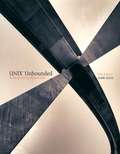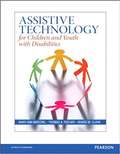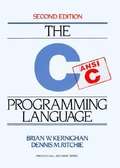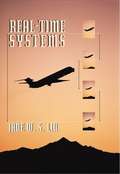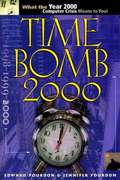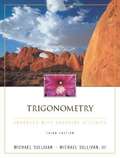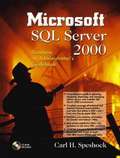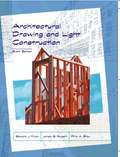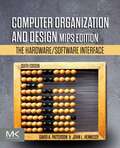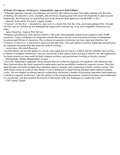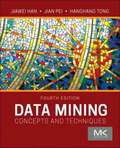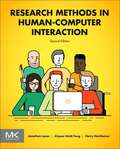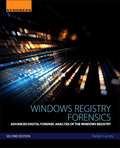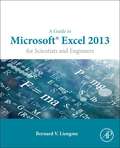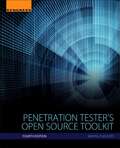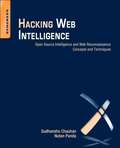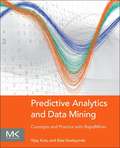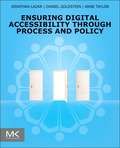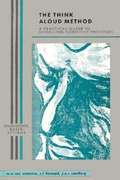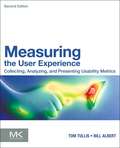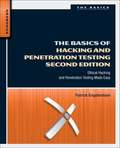- Table View
- List View
UNIX Unbounded: A Beginning Approach
by Amir AfzalUNIX Unbounded: A Beginning Approach is ideal for introductory courses in the UNIX operating system. It is also serves as a suitable introduction to UNIX for professionals. Using clear-cut examples, this tutorial introduces readers to the UNIX operating system, including its historical development, major versions, and important features. It covers the topics necessary for users to function independently and handle routine tasks, giving readers a foundation for exploring more advanced UNIX topics.
Assistive Technology For Children And Youth With Disabilities
by Mary Ann Marchel Denise M. Clark Thomas A. FischerEncompassing home, school and community environments, Assistive Technology for Children and Youth with Disabilities highlights the vast amount of supports available for children with disabilities from birth to age 21. An informative resource, the text details not only what types of assistive technology exist, but also how to select technology to meet specific students needs and match specific environmental circumstances. Chapters address the broad range of technologies now available, including supports for mobility, positioning, access, academic areas, behavior problems, recreation, and transitioning. Case examples, vignettes and activities provide practical, real-life examples that show how to use assistive technology to improve the independence and participation of students with special needs.
The C Programming Language (Second Edition)
by Brian Kernighan Dennis RitchieIntroduces the features of the C programming language, discusses data types, variables, operators, control flow, functions, pointers, arrays, and structures, and looks at the UNIX system interface.
Real-time Systems
by Jane W. S. LiuWritten by a renowned authority, this advanced text comprehensively covers the advances in real-time operating systems and communications networks, emphasizing research results that have been adopted in state-of-the-art systems.
Trigonometry Enhanced with Graphing Utilities (3rd Edition)
by Michael Sullivan"The Sullivan Enhanced with Graphing Utilities" series fully integrates the graphing calculator. These widely adopted books are known for their precise careful presentation of mathematics. This precision permeates the book and is particularly evident in the examples, pedagogy and exercises. This book includes coverage of trigonometric functions and their applications, analytic trigonometry, polar coordinates and vectors, and exponential and logarithmic functions. For anyone who needs to brush up on everyday or business-related mathematics.
Microsoft SQL Server 2000 Database Administrator's Guidebook
by Carl H. SpeshockThis isn't just a start-to-finish guide to Microsoft SQL Server 2000 database administration. It's a practical guide for those migrating from Oracle® or Sybase®plus an indispensable resource for managers who must hire and supervise SQL Server DBAs. Carl H. Speshock defines the SQL Server DBA role by covering every DBA skill required to administer and manage robust, secure, and scalable SQL Server environments-- both technical and managerial.
Business Computer Information Systems II (Texas Edition)
by Pearson EducationBusiness Computer Information Systems II presents advanced concepts and skills of Microsoft Office XP (Microsoft Word, Microsoft Excel, Microsoft Access, and Microsoft Outlook®). Through a learn-by-doing approach, students are challenged to master Microsoft Office within a business context. Additional features throughout the book also provide insight into how software can be used in other academic areas and in the business world.
Business Computer Information Systems I (Texas Edition)
by Prentice HallBusiness Computer information Systems I presents the basic concepts and skills of Microsoft Office XP (Microsoft Word, Microsoft Excel, Microsoft Access, Microsoft PowerPoint and Microsoft Outlook and also introduces fundamental computer concepts.
Architectural Drawing and Light Construction (6th Edition)
by Edward John Muller James G. Fausett Philip A. GrauUsing clear, concise explanations and numerous illustrations, this book introduces the basics of architectural design and practice along with construction documentation and practice. This book provides the most current information on architecture and construction including modern residential planning, environmental considerations, computer-aided design and drafting, building codes, and lettering.
SELECT Series: Microsoft Word 2002, Brief Volume
by Yvonne JohnsonThe Select Series: Steps for Success, Projects for Perspective. The Select family of texts boasts a lively look and feel that takes a step-by-step approach to teaching Word 2002 tasks. Not only does the student step through the tasks, but the emphasis on projects in this series gives the student practical knowledge of Word 2002. Microsoft Certified to the EXPERT level, these texts contain the depth of coverage your students need.
Computer Organization and Design MIPS Edition: The Hardware/Software Interface (The Morgan Kaufmann Series in Computer Architecture and Design)
by David A. Patterson John L. HennessyComputer Organization and Design: The Hardware/Software Interface, Sixth Edition, the leading, award-winning textbook from Patterson and Hennessy used by more than 40,000 students per year, continues to present the most comprehensive and readable introduction to this core computer science topic. Improvements to this new release include new sections in each chapter on Domain Specific Architectures (DSA) and updates on all real-world examples that keep it fresh and relevant for a new generation of students. <p>•Covers parallelism in-depth, with examples and content highlighting parallel hardware and software topics <p>•Includes new sections in each chapter on Domain Specific Architectures (DSA) <p>•Discusses and highlights the "Eight Great Ideas" of computer architecture, including Performance via Parallelism, Performance via Pipelining, Performance via Prediction, Design for Moore's Law, Hierarchy of Memories, Abstraction to Simplify Design, Make the Common Case Fast and Dependability via Redundancy
Designing With the Mind in Mind: Simple Guide to Understanding User Interface Design Guidelines
by Jeff JohnsonUser interface (UI) design rules and guidelines, developed by early HCI gurus and recognized throughout the field, were based on cognitive psychology (study of mental processes such as problem solving, memory, and language), and early practitioners were well informed of its tenets. But today practitioners with backgrounds in cognitive psychology are a minority, as user interface designers and developers enter the field from a wide array of disciplines. <p><p>HCI practitioners today have enough experience in UI design that they have been exposed to UI design rules, but it is essential that they understand the psychological basis behind the rules in order to effectively apply them. In Designing with the Mind in Mind, best-selling author Jeff Johnson provides designers with just enough background in perceptual and cognitive psychology that UI design guidelines make intuitive sense rather than being just a list of rules to follow.
Computer Architecture: A Quantitative Approach (The Morgan Kaufmann Series in Computer Architecture and Design)
by John L. Hennessy David A. PattersonComputer Architecture: A Quantitative Approach, Sixth Edition has been considered essential reading by instructors, students and practitioners of computer design for over 20 years. The sixth edition of this classic textbook from Hennessy and Patterson, winners of the 2017 ACM A.M. Turing Award recognizing contributions of lasting and major technical importance to the computing field, is fully revised with the latest developments in processor and system architecture. <p><p>The text now features examples from the RISC V (RISC Five) instruction set architecture, a modern RISC instruction set developed and designed to be a free and openly adoptable standard. It also includes a new chapter on domain specific architectures and an updated chapter on warehouse scale computing that features the first public information on Google's newest WSC.
Data Mining: Concepts and Techniques (The Morgan Kaufmann Series in Data Management Systems)
by Jiawei Han Jian Pei Hanghang TongData Mining: Concepts and Techniques, Fourth Edition introduces concepts, principles, and methods for mining patterns, knowledge, and models from various kinds of data for diverse applications. Specifically, it delves into the processes for uncovering patterns and knowledge from massive collections of data, known as knowledge discovery from data, or KDD. It focuses on the feasibility, usefulness, effectiveness, and scalability of data mining techniques for large data sets. <p><p>After an introduction to the concept of data mining, the authors explain the methods for preprocessing, characterizing, and warehousing data. They then partition the data mining methods into several major tasks, introducing concepts and methods for mining frequent patterns, associations, and correlations for large data sets; data classification and model construction; cluster analysis; and outlier detection. Concepts and methods for deep learning are systematically introduced as one chapter. Finally, the book covers the trends, applications, and research frontiers in data mining. <p><p>Presents a comprehensive new chapter on deep learning, including improving training of deep learning models, convolutional neural networks, recurrent neural networks, and graph neural networks. Addresses advanced topics in one dedicated chapter: data mining trends and research frontiers, including mining rich data types (text, spatiotemporal data, and graph/networks), data mining applications (such as sentiment analysis, truth discovery, and information propagation), data mining methodologies and systems, and data mining and society. Provides a comprehensive, practical look at the concepts and techniques needed to get the most out of your data
Research Methods In Human Computer Interaction
by Jonathan Lazar Jinjuan Heidi Feng Harry Hochheiser<P>Research Methods in Human-Computer Interaction is a comprehensive guide to performing research and is essential reading for both quantitative and qualitative methods.<P> Since the first edition was published in 2009, the book has been adopted for use at leading universities around the world, including Harvard University, Carnegie-Mellon University, the University of Washington, the University of Toronto, HiOA (Norway), KTH (Sweden), Tel Aviv University (Israel), and many others. <P>Chapters cover a broad range of topics relevant to the collection and analysis of HCI data, going beyond experimental design and surveys, to cover ethnography, diaries, physiological measurements, case studies, crowdsourcing, and other essential elements in the well-informed HCI researcher's toolkit.<P> Continual technological evolution has led to an explosion of new techniques and a need for this updated 2nd edition, to reflect the most recent research in the field and newer trends in research methodology.
Windows Registry Forensics: Advanced Digital Forensic Analysis Of The Windows Registry (Second Edition)
by Harlan CarveyWindows Registry Forensics: Advanced Digital Forensic Analysis of the Windows Registry, Second Edition, provides the most in-depth guide to forensic investigations involving Windows Registry. This book is one-of-a-kind, giving the background of the Registry to help users develop an understanding of the structure of registry hive files, as well as information stored within keys and values that can have a significant impact on forensic investigations. Tools and techniques for post mortem analysis are discussed at length to take users beyond the current use of viewers and into real analysis of data contained in the Registry. This second edition continues a ground-up approach to understanding so that the treasure trove of the Registry can be mined on a regular and continuing basis.
A Guide to Microsoft Excel 2013 for Scientists and Engineers
by Bernard V. LiengmeThis text provides a tutorial to using the functions of Microsoft Excel, guiding the reader from basic principles through to more complicated areas such as formulae, charts, curve-fitting, equation solving, integration, macros, statistical functions, and presenting quantitative data.
Penetration Tester's Open Source Toolkit
by Jeremy Faircloth<p>Continuing a tradition of excellent training on open source tools, Penetration Tester’s Open Source Toolkit, Fourth Edition is a great reference to the open source tools available today and teaches you how to use them by demonstrating them in real-world examples. This book expands upon existing documentation so that a professional can get the most accurate and in-depth test results possible. Real-life scenarios are a major focus so that the reader knows which tool to use and how to use it for a variety of situations. This updated edition covers the latest technologies and attack vectors, including industry specific case studies and complete laboratory setup. <p>Great commercial penetration testing tools can be very expensive and sometimes hard to use or of questionable accuracy. This book helps solve both of these problems. The open source, no-cost penetration testing tools presented work as well or better than commercial tools and can be modified by the user for each situation if needed. Many tools, even ones that cost thousands of dollars, do not come with any type of instruction on how and in which situations the penetration tester can best use them. Penetration Tester's Open Source Toolkil, Fourth Edition bridges this gap providing the critical information that you need.</p>
Hacking Web Intelligence: Open Source Intelligence and Web Reconnaissance Concepts and Techniques
by Sudhanshu Chauhan Nutan Kumar PandaOpen source intelligence (OSINT) and web reconnaissance are rich topics for infosec professionals looking for the best ways to sift through the abundance of information widely available online. In many cases, the first stage of any security assessment-that is, reconnaissance-is not given enough attention by security professionals, hackers, and penetration testers. Often, the information openly present is as critical as the confidential data. Hacking Web Intelligence shows you how to dig into the Web and uncover the information many don't even know exists. The book takes a holistic approach that is not only about using tools to find information online but also how to link all the information and transform it into presentable and actionable intelligence. You will also learn how to secure your information online to prevent it being discovered by these reconnaissance methods. Hacking Web Intelligence is an in-depth technical reference covering the methods and techniques you need to unearth open source information from the Internet and utilize it for the purpose of targeted attack during a security assessment. This book will introduce you to many new and leading-edge reconnaissance, information gathering, and open source intelligence methods and techniques, including metadata extraction tools, advanced search engines, advanced browsers, power searching methods, online anonymity tools such as TOR and i2p, OSINT tools such as Maltego, Shodan, Creepy, SearchDiggity, Recon-ng, Social Network Analysis (SNA), Darkweb/Deepweb, data visualization, and much more. Provides a holistic approach to OSINT and Web recon, showing you how to fit all the data together into actionable intelligence Focuses on hands-on tools such as TOR, i2p, Maltego, Shodan, Creepy, SearchDiggity, Recon-ng, FOCA, EXIF, Metagoofil, MAT, and many more Covers key technical topics such as metadata searching, advanced browsers and power searching, online anonymity, Darkweb / Deepweb, Social Network Analysis (SNA), and how to manage, analyze, and visualize the data you gather Includes hands-on technical examples and case studies, as well as a Python chapter that shows you how to create your own information-gathering tools and modify existing APIs
Predictive Analytics And Data Mining: Concepts And Practice With Rapidminer
by Vijay Kotu Bala DeshpandePut Predictive Analytics into Action Learn the basics of Predictive Analysis and Data Mining through an easy to understand conceptual framework and immediately practice the concepts learned using the open source RapidMiner tool. Whether you are brand new to Data Mining or working on your tenth project, this book will show you how to analyze data, uncover hidden patterns and relationships to aid important decisions and predictions. Data Mining has become an essential tool for any enterprise that collects, stores and processes data as part of its operations. This book is ideal for business users, data analysts, business analysts, business intelligence and data warehousing professionals and for anyone who wants to learn Data Mining. You'll be able to: 1. Gain the necessary knowledge of different data mining techniques, so that you can select the right technique for a given data problem and create a general purpose analytics process. 2. Get up and running fast with more than two dozen commonly used powerful algorithms for predictive analytics using practical use cases. 3. Implement a simple step-by-step process for predicting an outcome or discovering hidden relationships from the data using RapidMiner, an open source GUI based data mining tool Predictive analytics and Data Mining techniques covered: Exploratory Data Analysis, Visualization, Decision trees, Rule induction, k-Nearest Neighbors, Na ve Bayesian, Artificial Neural Networks, Support Vector machines, Ensemble models, Bagging, Boosting, Random Forests, Linear regression, Logistic regression, Association analysis using Apriori and FP Growth, K-Means clustering, Density based clustering, Self Organizing Maps, Text Mining, Time series forecasting, Anomaly detection and Feature selection. Implementation files can be downloaded from the book companion site at www.LearnPredictiveAnalytics.com Demystifies data mining concepts with easy to understand language Shows how to get up and running fast with 20 commonly used powerful techniques for predictive analysis Explains the process of using open source RapidMiner tools Discusses a simple 5 step process for implementing algorithms that can be used for performing predictive analytics Includes practical use cases and examples
Ensuring Digital Accessibility through Process and Policy
by Jonathan Lazar Daniel Goldstein Anne TaylorThis book provides readers with a resource to digital accessibility from both a technical and policy perspective.
The Think Aloud Method: A practical guide to modelling cognitive processes
by "Maarten W. van Someren Yvonne F. Barnard Jacobijn A. C. Sandberg "This book presents a detailed description of the Think Aloud Method, which was developed to facilitate knowledge acquisition and problem-solving by asking the participant to think aloud while solving a problem. The Think Aloud Method is based on the premise that people are often able to verbalize their thoughts as they solve a problem, and their resulting behavior can be analyzed to answer questions about problem solving behavior. This method is useful for psychological research on problem solving behavior, as well as for knowledge acquisition in the context of building expert computer programs. In many cases the Think Aloud Method is an invaluable source of information for psychologists and knowledge engineers.
Measuring the User Experience: Collecting, Analyzing, and Presenting Usability Metrics (Second Edition)
by William Albert Thomas TullisMeasuring the User Experience was the first book that focused on how to quantify the user experience. Now in the second edition, the authors include new material on how recent technologies have made it easier and more effective to collect a broader range of data about the user experience. As more UX and web professionals need to justify their design decisions with solid, reliable data, Measuring the User Experience provides the quantitative analysis training that these professionals need. The second edition presents new metrics such as emotional engagement, personas, keystroke analysis, and net promoter score. It also examines how new technologies coming from neuro-marketing and online market research can refine user experience measurement, helping usability and user experience practitioners make business cases to stakeholders. The book also contains new research and updated examples, including tips on writing online survey questions, six new case studies, and examples using the most recent version of Excel. Learn which metrics to select for every case, including behavioral, physiological, emotional, aesthetic, gestural, verbal, and physical, as well as more specialized metrics such as eye-tracking and clickstream data. Find a vendor-neutral examination of how to measure the user experience with web sites, digital products, and virtually any other type of product or system. Discover in-depth global case studies showing how organizations have successfully used metrics and the information they revealed. Companion site, www. measuringux. com, includes articles, tools, spreadsheets, presentations, and other resources to help you effectively measure the user experience
The Basics of Hacking and Penetration Testing: Ethical Hacking and Penetration Testing Made Easy
by David Kennedy Patrick EngebretsonThe Basics of Hacking and Penetration Testing serves as an introduction to the steps required to complete a penetration test or perform an ethical hack. You learn how to properly utilize and interpret the results of modern day hacking tools; which are required to complete a penetration test. Tool coverage will include, Backtrack Linux, Google, Whois, Nmap, Nessus, Metasploit, Netcat, Netbus, and more. A simple and clean explanation of how to utilize these tools will allow you to gain a solid understanding of each of the four phases and prepare them to take on more in-depth texts and topics. This book includes the use of a single example (pen test target) all the way through the book which allows you to clearly see how the tools and phases relate. Each chapter contains hands-on examples and exercises that are designed to teach you how to interpret the results and utilize those results in later phases. Written by an author who works in the field as a Penetration Tester and who teaches Offensive Security, Penetration Testing, and Ethical Hacking, and Exploitation classes at Dakota State University. Utilizes the Kali Linux distribution and focuses on the seminal tools required to complete a penetration test.
